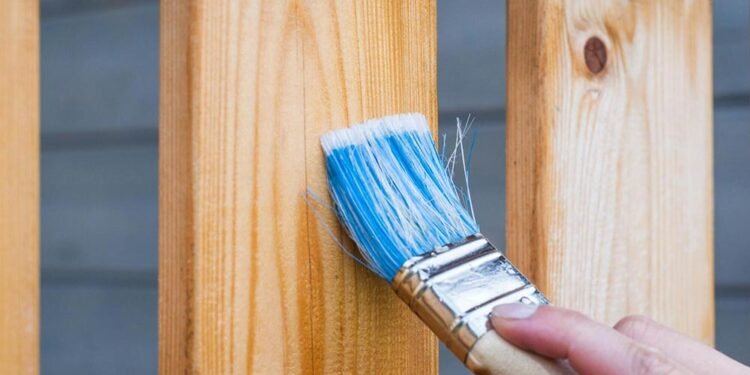Faux wood paint is a creative solution that transforms plain surfaces into elegant wood-like finishes. Masters of this craft would employ their skills to mimic the luster and texture of various wood species.
For a beginner, the task might seem daunting. However, with the right guidance, practice, and a touch of patience, anyone can master the art of faux wood grain painting. Let’s dive into these tips to lay the groundwork for your first – or next – faux wood project.
Choose the Right Base
Selecting the correct base is the cornerstone of any successful faux wood project. Your base – typically a piece of furniture, a wall, or any other item you wish to transform – dictates the outcome and affects how the faux wood finish binds to the surface.
Begin With a Smooth Surface
Ensure the surface is as smooth as possible and free from dents, scratches, and old paint. This attention to detail at the start will save you time during the finishing stages. Sanding the surface to a smooth finish is often necessary, especially if you’re working with a rough or previously painted surface.
Material Matters
Different materials, from metal to plastic, will require different primers and techniques. If unsure, consult with professionals from Fresh Coat Painters of Augusta.
They use only the best quality paints and materials and provide professional and quality services. Or start with a wooden surface for easier handling.
Prep the Surface
Preparation is key to a lasting faux wood finish. It’s not about taking shortcuts; it’s about setting yourself – and your project – up for success.
Clean Thoroughly
Use a degreaser to remove any grime or oils that may interfere with the paint adhesion. A clean surface ensures the paint goes on smoothly.
Prime Your Surface
A good primer helps the faux wood finish to bond and adhere better. It also prevents any stains or tannins from seeping through the topcoat. Use a primer specifically designed for your base material.
Fill in Cracks and Holes
Fill any gaps, cracks, or holes with a wood filler or putty. This will ensure a smooth surface for painting. Sand down any excess filler once it dries.
Use the Right Tools
The right tools aren’t just for a better finish; they also make the process more enjoyable. Investing in quality tools will save you from frustration down the line.
Brushes and Rollers
Quality brushes and rollers with different textures help to create various wood grain patterns. Test different sizes and textures to see what works best for you.
Faux Finish Tools
Tools such as faux wood rocker combs, wood graining tools, and rags can help achieve the perfect finish. Don’t be afraid to experiment with different techniques and tools to create unique patterns.
Master the Technique
The technique is where the magic happens. This step requires practice, but the results are worth the effort.
Watch and Learn
Before starting your project, watch tutorials and observe how professional faux wood painters create different grain patterns. Notice how they use different tools and faux wood techniques to achieve a realistic wood finish.
Practice Makes Perfect
Practice on a scrap piece of wood or cardboard before tackling your project. This will help you perfect your technique and gain confidence before working on the real thing.
Experiment With Colors
An experienced wood grainer can mimic over a dozen wood species with different colors and layering. For beginners, start with a palette that represents your favorite wood and adjust as necessary.
Be Patient With Stain
Stain layers take time to dry, but each layer builds depth and complexity. The use of glazes can also enrich the color and finish. Experiment with different combinations to achieve unique results.
Layer Light Over Dark
Start with your lightest color and gradually add darker stains for a realistic appearance. Use a dry brush technique to blend and soften the colors.
Add Depth and Texture
Depth is what sets apart a good faux painting from a great one. Adding texture and dimension makes the wood look real to the touch.
Damp Cloth Dragging
A damp cloth dragged across the paint and the glaze adds a natural grain. Experiment with different dragging techniques to achieve various wood grain patterns.
Use a Dry Brush
A dry brush technique involves dipping the brush into the paint and then removing most of it. Lightly drag the brush across your surface, creating subtle lines that mimic grain patterns.
Seal and Protect
Congratulations, you’ve created a beautiful faux wood finish. Now protect it to ensure it lasts for years to come.
Choose the Right Sealant
Different surfaces may require different sealants. Consult your local hardware store for recommendations. However, most faux wood finishes will benefit from a coat of polyurethane or varnish to seal and protect the surface.
Apply Multiple Coats
Multiple coats of sealant help to build a strong protective layer. Be sure to follow the manufacturer’s instructions for drying time between coats.
Apply With Care
Whether spraying or brushing, be methodical in your sealant application to avoid runs and drips. Use a high-quality brush to ensure an even finish.
Troubleshooting Common Issues
Even the best artists encounter problems. Knowing how to troubleshoot will save your project from becoming a faux pas.
Crackling
If your paint cracks, the surface may not have been prepped properly. Sand down the affected area, re-prepare, and repaint.
Blotchiness
Blotchy finishes can result from using old or low-quality paint. Use high-quality paints specifically designed for faux wood painting.
Inspiring Ideas for Your Faux Wood Paint Projects
When you’re ready to start your faux wood paint journey, think about the exciting projects you can do. Take simple items like picture frames or flower pots. Paint them with faux wood to add a style boost to your space.
Give your old chairs, tables, or bookshelves a new life. Turn them into beautiful wood pieces without spending a lot. Or create an accent wall that stands out.
Your room will feel cozy with a wall that looks like it’s covered in wood.
The Transformational Effect of Faux Wood Paint
Faux wood paint is more than a mere aesthetic enhancer; it’s a transformative tool that breathes life into plain objects around us. As you follow these tips and dive into your first project, remember that practice makes progress.
Each project is a learning opportunity to refine your skills and develop your unique style. Don’t be discouraged by imperfections; they often lead to the most interesting and authentic results.
For more hiring tips and tricks, check out the rest of our blog.












